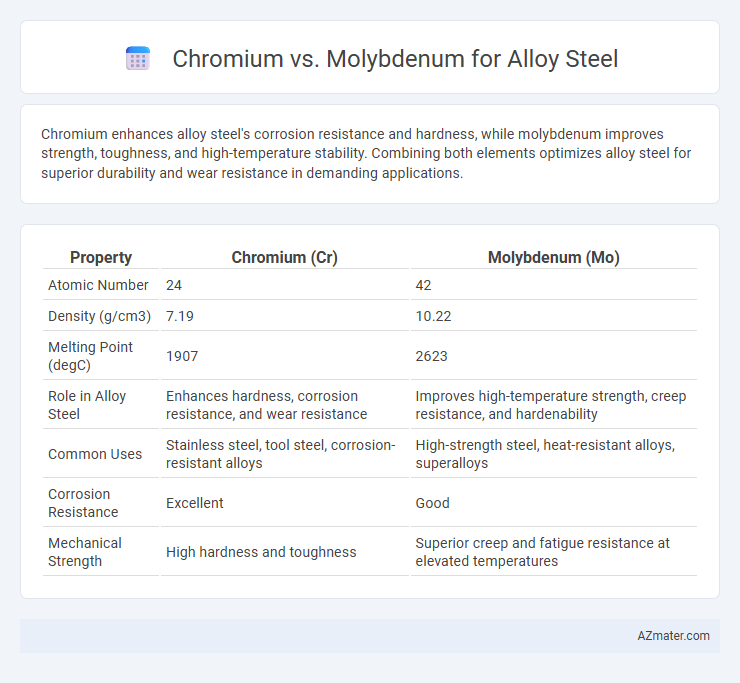Chromium enhances alloy steel's corrosion resistance and hardness, while molybdenum improves strength, toughness, and high-temperature stability. Combining both elements optimizes alloy steel for superior durability and wear resistance in demanding applications.
Table of Comparison
| Property | Chromium (Cr) | Molybdenum (Mo) |
|---|---|---|
| Atomic Number | 24 | 42 |
| Density (g/cm3) | 7.19 | 10.22 |
| Melting Point (degC) | 1907 | 2623 |
| Role in Alloy Steel | Enhances hardness, corrosion resistance, and wear resistance | Improves high-temperature strength, creep resistance, and hardenability |
| Common Uses | Stainless steel, tool steel, corrosion-resistant alloys | High-strength steel, heat-resistant alloys, superalloys |
| Corrosion Resistance | Excellent | Good |
| Mechanical Strength | High hardness and toughness | Superior creep and fatigue resistance at elevated temperatures |
Introduction to Alloy Steel and Key Alloying Elements
Alloy steel is a type of steel distinguished by the presence of alloying elements that enhance its mechanical properties and corrosion resistance. Chromium and molybdenum are two key alloying elements; chromium improves hardness, tensile strength, and oxidation resistance, while molybdenum increases toughness, wear resistance, and high-temperature strength. The combination of chromium and molybdenum in alloy steel results in materials ideal for demanding industrial applications requiring durability and resilience.
Chromium: Properties and Role in Alloy Steel
Chromium significantly enhances corrosion resistance, hardness, and wear resistance in alloy steel, making it essential for stainless steel production. Its ability to form a stable, passive oxide layer prevents oxidation and extends material lifespan in harsh environments. Chromium's contribution to increased tensile strength and toughness optimizes alloy steels for demanding industrial applications such as automotive, aerospace, and construction.
Molybdenum: Properties and Role in Alloy Steel
Molybdenum in alloy steel significantly enhances strength, toughness, and corrosion resistance, outperforming chromium in high-temperature stability and creep resistance. It improves hardenability and inhibits grain growth, making steels more durable under extreme conditions. Its ability to form stable carbides contributes to wear resistance and maintains structural integrity in demanding industrial applications.
Comparative Impact on Steel Hardness
Chromium significantly enhances steel hardness by forming hard chromium carbides that improve wear resistance and toughness, making it ideal for high-strength alloy steels. Molybdenum increases hardness primarily through solid solution strengthening and refining grain size, which enhances creep resistance and toughness at elevated temperatures. While both elements improve hardness, chromium provides superior surface hardness and wear resistance, whereas molybdenum excels in maintaining hardness under thermal stress conditions.
Corrosion Resistance: Chromium vs Molybdenum
Chromium significantly enhances alloy steel's corrosion resistance by forming a stable, passive oxide layer that protects the metal surface from rust and chemical attack. Molybdenum further improves this resistance, especially against pitting and crevice corrosion in chloride-rich environments, making it essential for marine and acidic applications. Combining chromium and molybdenum in alloy steel offers superior protection against a wide range of corrosive agents compared to using chromium alone.
Effects on High-Temperature Performance
Chromium enhances alloy steel's high-temperature oxidation resistance by forming a stable oxide layer that protects the metal surface. Molybdenum improves high-temperature strength and creep resistance through carbide formation, contributing to structural stability under prolonged stress. Combining chromium and molybdenum in alloy steel optimizes both oxidation resistance and mechanical durability at elevated temperatures.
Influence on Steel Strength and Toughness
Chromium significantly enhances steel strength by forming hard carbides that improve wear resistance and contribute to higher tensile strength, while also increasing toughness through grain refinement. Molybdenum strengthens alloy steel by promoting solid solution strengthening and stabilizing carbides, which improves high-temperature strength and resistance to softening. The synergistic combination of chromium and molybdenum results in alloy steels with superior overall mechanical properties, balancing enhanced strength and toughness for demanding applications.
Cost Considerations: Chromium vs Molybdenum Alloys
Chromium alloys generally offer a more cost-effective option compared to molybdenum alloys due to the wider availability and lower market price of chromium. Molybdenum, with its superior high-temperature strength and corrosion resistance, commands a premium price, impacting the overall cost of alloy steel production. Selecting between chromium and molybdenum alloys involves balancing performance requirements against budget constraints, with chromium alloys favored for cost-sensitive applications and molybdenum alloys preferred for demanding environments.
Common Applications in Industry
Chromium enhances alloy steel's hardness, corrosion resistance, and wear resistance, making it ideal for stainless steel production, automotive parts, and cutting tools. Molybdenum improves strength, toughness, and creep resistance at high temperatures, commonly used in aerospace components, pressure vessels, and industrial gas turbines. Both elements significantly boost alloy steel performance but serve distinct industrial applications based on their unique properties.
Choosing the Right Alloying Element for Steel
Selecting chromium or molybdenum as alloying elements for steel depends on the intended application and desired properties. Chromium enhances corrosion resistance and hardness, making it ideal for stainless steel and wear-resistant materials, while molybdenum significantly improves high-temperature strength and creep resistance, essential for heat-resistant and pressure vessel steels. Balancing these elements optimizes toughness, machinability, and durability in specialized alloy steels.

Infographic: Chromium vs Molybdenum for Alloy Steel
 azmater.com
azmater.com